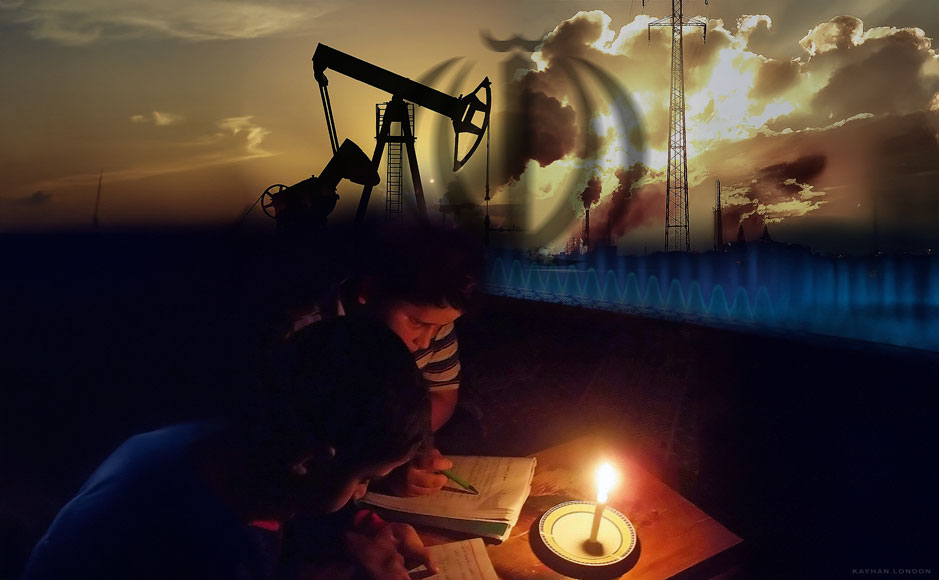By Kayhan Life Staff
Indicators of an energy crisis in Iran have been apparent for some time, but new developments have emerged in recent weeks. The Ministry of Energy has taken the unprecedented step of enforcing electricity rationing for households nationwide during the warmer months. Unlike previous years when industrial gas quotas were reduced in late fall, this year, they were slashed by 50 percent at the start of October.
In a recent report, the Majlis (Iranian Parliament) Research Center highlighted that a significant gas, diesel, and fuel oil shortage was the primary reason for the electricity deficit. Four months after taking office, President Massoud Pezeshkian’s government has yet to provide a plan or strategy to address this critical energy crisis despite the country’s rich natural resources.
OPINION: Iran Could Profit From Its Natural Gas Resources, Export Electricity
Since the start of last week, households across Iran have been experiencing electricity cuts lasting at least two hours each day. The state-owned Power Generation and Distribution Company, TAVANIR, implements these outages in major cities based on a neighborhood zoning plan.
However, power cuts can occur in smaller towns and rural areas without prior notification as well. This situation arises during the fall, a season typically not associated with peak electricity demand.
Government representatives from Pezeshkian’s administration, including spokesperson Fatemeh Mohajerani, have noted that diesel fuel has been banned in three power plants in Arak, Karaj, and Isfahan. They argue that the measure aims to protect public health and the environment. The initiative has evolved into a nationwide strategy for managing power outages, designed to mitigate the production deficit caused by the restrictions placed on these three facilities.
Despite repeated assertions by government officials in recent days, this claim has come under scrutiny. The government claims that diesel fuel accounts for 7 percent of the urban pollution attributed to power plants, while the combined usage of diesel and gasoline fuels is reportedly nearly 80 percent.
Meanwhile, Pezeshkian’s administration, which claims to prioritize public health and environmental concerns, has proposed no strategies to address the primary sources of pollution in various cities.
A recent analysis from the Majlis Research Center reveals that government officials misunderstand the rationale behind prohibiting diesel fuel use in three power plants in Karaj, Arak, and Isfahan. The report shows that the nation is experiencing a critical shortage of gas and diesel fuel, leading to disruptions in fuel supply for generating power. The report identifies the primary reasons behind the outages and power shortages.
However, just three days before, Mohajerani made a misleading statement on X: “It is unjust for part of society to risk their lives for electricity production. Therefore, following the president’s directive, the use of fuel oil will cease in the three power plants in Arak, Karaj, and Isfahan. For a limited duration, ‘scheduled power cuts’ may serve as an alternative to ‘toxic production’ for the public.”
In recent years, during the winter months, when gas consumption rises, power plants have relied on diesel fuel without encountering issues in meeting the country’s electricity demands. However, starting in October, the effects of the gas shortage have become clear, with gas allocations to industries being cut by 20 to 50 percent.
In prior years, during similar gas shortage crises in winter, these reductions typically began in late fall. The fuel scarcity in Iran has led to a “catastrophic” situation, with experts cautioning that this alarming trend is beyond government control and that shortages are likely to escalate.
The energy crisis in Iran is like a “time bomb” poised to detonate at any moment. Some experts have also raised concerns about the potential security and political ramifications of the energy shortfall and rising energy prices.
Besides the public relations strategies employed by officials in the Pezeshkian government regarding the reasons behind electricity rationing, which a government spokesperson described as an “organized blackout,” the statistics reveal the severity of Iran’s energy crisis.
Whereas discussions a few years ago focused on energy imbalance, defined as the gap between production and consumption, experts now assert that Iran is experiencing a shortage across all forms of energy.
Oil Minister Mohsen Paknejad noted that the current administration has inherited power plant reserves that have decreased by approximately 40 to 45 percent compared to last year.
The Majlis Research Center reported that in 2022, the natural gas imbalance peaked at 315 million cubic meters per day during high consumption periods. Although this figure dropped to around 280 million cubic meters per day because of rising temperatures in 2023, the imbalance persists throughout the year, particularly during colder months.
The report shows that the use of liquid fuel in thermal power plants has risen, while the stockpiles of diesel and fuel oil at these facilities have diminished during the first half of the Iranian calendar year (which begins on March 21) compared to the same timeframe last year.
This situation, coupled with increased gas supply imbalances and the lack of alternative liquid fuels, has posed significant challenges for electricity provision during winter.
Hashem Oreyee, head of the Union of Iranian Energy Scientific Associations, previously reported a summer electricity shortfall of 18,000 megawatts and projected that this deficit could escalate to 24,000 megawatts. He also noted a daily diesel shortage of 5 million liters.
According to Oreyee, the average shortfall is 250 million cubic meters of gas, while production levels have stagnated at 800 million cubic meters for an extended period with no increase. He noted that this average deficit is projected to rise to 350 million cubic meters soon, representing a 50 percent shortfall.
US Officials Believe Israel Will Target Military and Energy Sites in Iran, NBC Reports
Iran’s gas production would need to be increased by 50 percent beyond current levels to meet domestic consumption needs.
Also, the Islamic Republic cannot proceed with import contracts because of unresolved financial issues with energy-exporting nations.
Pezeshkian recently highlighted this situation: “Today’s war is an economic war. It is not a war of bombs and missiles. The enemy cannot defeat us militarily, but we have problems in economic warfare.”
He noted Turkmenistan has expressed reluctance to enter a gas contract with Iran, citing concerns over the Iranian government’s failure to make payments.
Last week, the Iranian government permitted the unrestricted import of premium gasoline. The cabinet approved a resolution that allows legal entities licensed by the Oil Ministry to import and distribute premium gasoline at a market price without subsidies. Experts view this move as a sign that gasoline prices may rise.
Gasoline production in the country does not meet consumption levels. Reports show that daily gasoline production reached 104 million liters, while daily consumption during the first half of this year (from April to October) was 124.5 million liters, resulting in a daily shortfall of approximately 20 million liters.
This energy crisis in Iran — home to the fourth-largest oil reserves and second-largest gas reserves globally, with 160.12 billion barrels of oil and 32.5 trillion cubic meters of gas — highlights the government’s failure to develop the oil and gas sector effectively, which has hindered citizens from reaping the benefits of these national resources.
Before the Islamic Revolution in 1979, Iran ranked as the third largest oil producer globally, following the U.S. and Saudi Arabia. According to a report from the UN Department of Economic and Social Affairs published in 2020, Iran has since dropped to the tenth position in oil production worldwide.
In recent years, the Iranian economy has experienced a decline of approximately 45 percent in its oil production capacity compared to before 1979. Over the last four decades, the Islamic Republic has not implemented adequate measures for developing its oil, gas, and petrochemical sectors, relying predominantly on revenue from crude oil sales.
A portion of this revenue has been allocated to cover current government expenses, while another segment has been directed towards promoting the government’s regional and global ideological objectives, including funding for government proxies. Also, some proceeds from crude oil sales have been misappropriated by insiders within a corrupt governmental framework.
The current situation in Iran’s energy sector reflects the consequences of decades of ineffective and mismanaged government actions. Over the past fifty years, these shortcomings have led to widespread destruction and crises.
One significant outcome has been the frequent power and gas outages affecting the industrial sector, resulting in a notable decline in production levels. This decline has caused substantial financial losses for industrial and manufacturing enterprises, contributing to increased economic stagnation throughout the country.
ANALYSIS -Iran’s Thirsty Energy Industry Runs up Against Water Shortage
In a process detrimental to the country’s development, the Islamic Republic has misused the nation’s foreign exchange reserves for various ideological objectives and money laundering activities. These financial resources should have been allocated towards enhancing productive capacities and improving infrastructure across different sectors. Instead, their diversion has hindered economic growth and stability.
Government officials admit substantial investments are required to revitalize Iran’s energy industries. Specifically, it is estimated that $160 billion is needed for the oil industry, $80 billion for the gas industry, and $70 billion for the petrochemical sector. Without these investments, the sustainability of these critical industries remains at risk.














